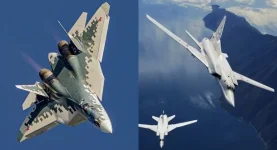- Views: 6K
- Replies: 31

Russia is making a renewed push to entice India with its Su-57E fifth-generation fighter jet, now boasting upgrades that include hypersonic weapons, enhanced stealth features, and improved avionics. To sweeten the deal, Russia has reportedly lowered the aircraft's cost and expressed willingness to accept payment in Indian rupees.
However, despite these incentives, India remains cautious. Concerns persist about Russia's ability to deliver on its promises, particularly regarding technology transfer, the reliability of the new engine, and the potential impact this acquisition could have on India's own fifth-generation fighter program, the AMCA.
India's pursuit of fifth-generation fighters is driven by the evolving regional security landscape. Facing potential conflicts with both China and Pakistan, whose air power is rapidly advancing, India recognizes the need for cutting-edge technology to maintain air superiority.
Additionally, much of the Indian Air Force's existing fleet is aging, necessitating replacement with more capable aircraft. While the AMCA is envisioned as a long-term solution, interim measures are needed to address immediate security gaps.
The Su-57E, with its redesigned airframe, aims to deliver enhanced stealth capabilities. However, doubts persist about its radar cross-section compared to other fifth-generation fighters.
The aircraft is equipped with advanced avionics, including AESA radar and electronic warfare systems, to improve survivability and situational awareness.
The planned integration of the Izdeliye 30 engine promises increased thrust, supercruise capability, and thrust vectoring, but delays in its development have cast a shadow on the Su-57E's overall readiness.
India and Russia have a long-standing defence partnership, with Russia being a major supplier of military equipment, including MiG and Sukhoi fighter jets. However, a previous joint venture to develop a fifth-generation fighter, the FGFA program, fell apart in 2018 due to disagreements over technology transfer, cost, and performance. This past experience contributes to India's current cautious approach.
A key concern for India is the potential impact of the Su-57E on the AMCA program. While access to advanced Russian technology could offer valuable insights, it could also divert resources and potentially hinder the AMCA's development. Furthermore, relying on foreign technology contradicts India's ambition to achieve self-reliance in defence.
Acquiring the Su-57E also raises geopolitical concerns. Strengthening defence ties with Russia could strain India's growing relationships with Western defence partners and risk sanctions from the United States.
India's decision on the Su-57E will be a complex one, balancing immediate operational needs with long-term strategic goals. While the upgraded aircraft offers significant capabilities, concerns about technology transfer, engine reliability, and the potential consequences for the AMCA program remain significant hurdles.
India must carefully weigh these factors alongside the geopolitical implications before making a decision that aligns with its broader defence strategy and ambitions for technological autonomy.



